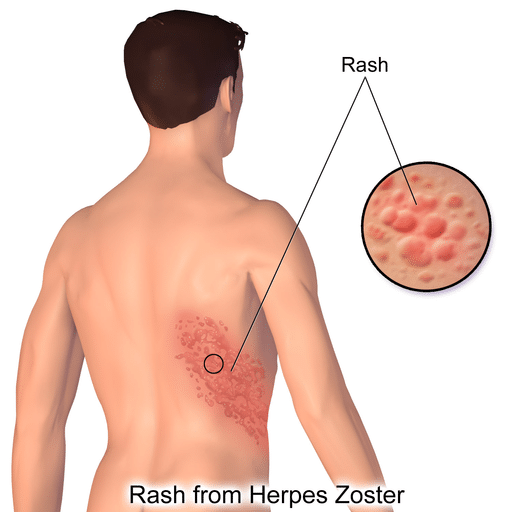Post-herpetic Neuralgia

Post-herpetic neuralgia is a chronic neuropathic pain that develops following Acute Herpes zoster (Shingles) infection aka Naagin in 10% of the patients. It is a very severe pain which continues after the resolution of initial phase of Herpes zoster (HZ) infection and then can persist for months to years, negatively impacting patient’s quality of life. This pain has a dermatomal distribution and is confined to same region as the original rash. Thus, It can involve your Face , trunk , upper limbs or lower limbs.
Patho-physiology of Post herpetic neuralgia:
Acute Herpes zoster infection from activation of the varicella zoster virus (VZV) infection, which is latent in the dorsal root ganglia since the initial infection (varicella). The virus replicates in the ganglionic neurones then travels down the nerves to infect the skin where it results in blister formation. Subsequent healing of the lesions produces the characteristic scars on the body. This viral infection also brings about functional and structural changes in the Dorsal root ganglion which forms the basis for the development of Post-herpetic neuralgia.
Post-herpetic neuralgia subsides eventually on its own. However, it may make patients suffer for years and may leave a band of anaesthetic skin. It may lead to muscle weakness as well, if it affects major motor nerve.
Signs and Symptoms
There are mainly 3 components of Post-herpetic neuralgia:
- Pain: which can have various kind of presentations
- Constant aching, deep, or burning pain
- Paroxysmal lancinatingpain
- Hyperalgesia(increased sensitivity to pain)
- Allodynia(pain associated with non-painful stimuli)
- Sensory abnormalities in scarred skin :These may take the form of
- Negative symptoms:Hypo-aesthesia or decreased sensations in the scarred region
- Positive symptoms:Allodynia and Hyper-aesthesia
- Psychiatric symptoms :Mood disorders or Depression.
Risk Factors
- Old age
- Poor immunity
- Severity of acute pain of HZ
- Greater rash severity
- Painful prodrome preceding acute symptoms
- Sensory dysfunction in dermatome during HZ
- Fever
- Psychosocial stress
JEEVISHA protocol for management of Post-herpetic neuralgia:
Medications and other conservative treatment options: Patients are generally started on Neuropathic and Anti- Convulsant medications. Doses are slowly titrated to get the adequate pain relief with minimum side effects.
However, if used alone, most of patients develop tolerance or side-effects to the prescribed medications.
Thus, at our centre we use Multiple modalities which when combined prevent early development of side effects of the medications. These include
- Perineural Dry needling in the area of distribution of the particular branch involved
- Botox injections which not only reduce the muscle spams associated with this condition but also produce neuromodulation and subsequent reduction in disease symptoms.
Targeted treatment:
- Ultrasound/ Fluoroscopy guided nerve root injections and Pulsed Radiofrequency ablation
- Ultrasound/ Fluoroscopy guided epidural injections
- Ultrasound/ Fluoroscopy guided Intercostal nerve Radiofrequency ablation
- Ultrasound/ Fluoroscopy guided Gasserian ganglion Pulsed Radiofrequency ablation
- Ultrasound/ Fluoroscopy guided peripheral nerve( Supra-orbital/ Infra-orbital) injections/ Radiofrequency ablation.